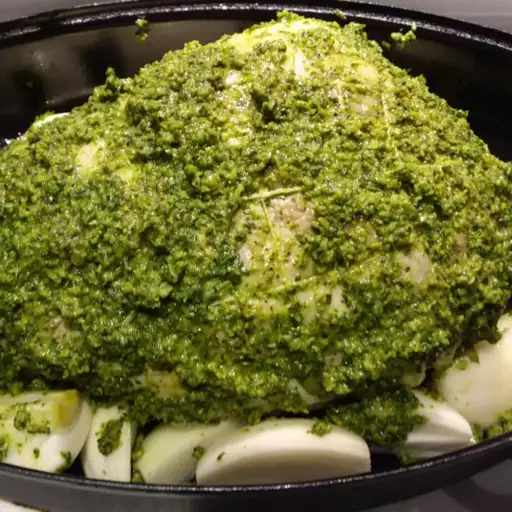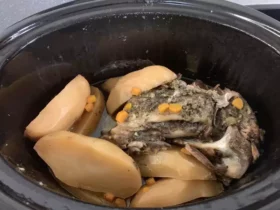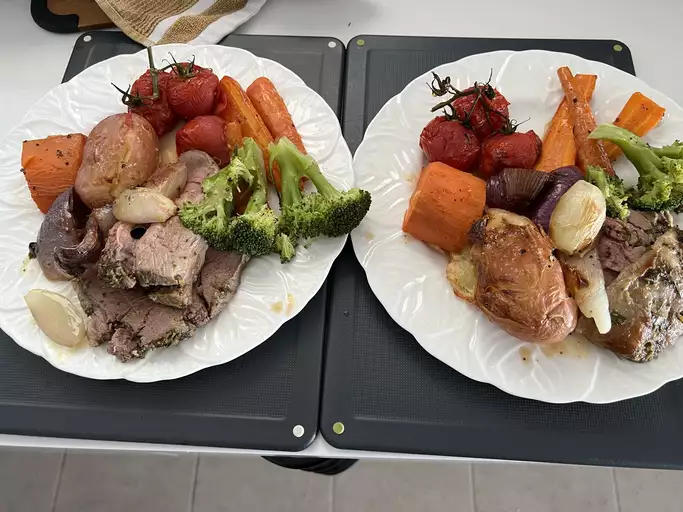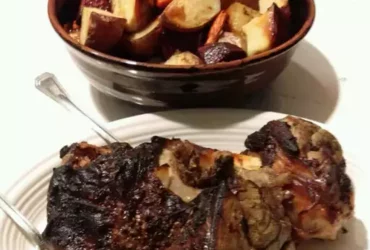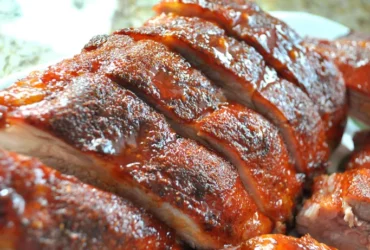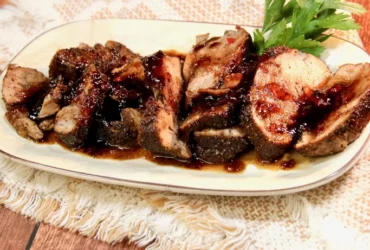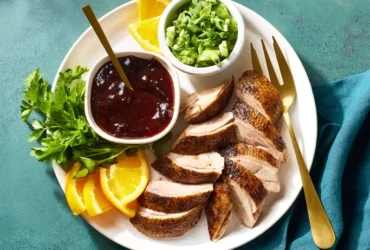Preparation and Ingredients
Choosing the Right Leg of Lamb
Preparing the perfect Easter leg of lamb requires attention to detail and a focus on selecting the right ingredients.
To begin, it’s essential to choose a high-quality leg of lamb that suits your needs. Here are some factors to consider:
- Select a bone-in or boneless leg of lamb, depending on personal preference and ease of carving.
- Look for a leg with even marbling – this will not only add flavor but also help to keep the meat tender during cooking.
- A good leg of lamb should have a layer of fat around the edges, as this will help to keep it moist and add richness to the finished dish.
- Choose a leg that’s around 2-3 pounds in weight – this will ensure you have enough meat for your gathering without having too much leftover.
In terms of ingredients, here are some essentials you’ll need:
- 1 leg of lamb (around 2-3 pounds)
- 2 cloves of garlic, minced
- 2 sprigs of fresh rosemary, chopped
- 2 tablespoons olive oil
- 1 tablespoon lemon juice
- Salt and pepper to taste
You’ll also want to have some aromatics on hand, such as onions and carrots – these will add depth of flavor to the lamb during cooking.
In terms of seasonings, you can use a combination of salt, pepper, and dried herbs like thyme and oregano to give your lamb extra flavor. Be sure to rub the seasoning mixture all over the leg, making sure to get some under the fat as well.
Select a bone in leg of lamb, ideally with the femur still attached
Selecting the perfect bone-in leg of lamb for your Easter celebration is crucial to ensure a tender and flavorful dish. Ideally, choose a leg that still has its femur attached, as this will help keep the meat moist and add extra flavor during cooking. Look for a leg with a good balance of fat and lean meat, as this will contribute to its tenderness.
When selecting your leg of lamb, consider the size you need. A 1.5-2 pound bone-in leg is ideal for a smaller gathering or as an addition to a larger Easter spread. If you’re hosting a bigger group, opt for a slightly larger leg, up to 3 pounds.
The shape and symmetry of the leg are also important factors to consider. Choose a leg with a rounded, even shape, which will ensure that it cooks evenly. A well-shaped leg will also be more visually appealing when sliced and served.
Avoid legs that are too thin or have excessive fat deposits, as these can be difficult to cook through consistently. Also, steer clear of any legs with visible signs of damage or bruising, which can lead to uneven cooking and affect the overall texture of the meat.
For an Easter leg of lamb recipe, you’ll want to select a cut that has been trimmed properly. Look for a bone-in leg that’s been trimmed to about 1/4 inch thick on all sides. This will ensure even cooking and prevent the meat from becoming tough or overcooked in certain areas.
Lastly, consider the breed of the lamb when selecting your leg. Some breeds, such as those with a higher percentage of fat, may be more suitable for slow-cooking methods like braising or roasting. Other breeds, like those with leaner meat, are better suited to faster cooking techniques like grilling or pan-searing.
Look for meat that is well marbled, but not too fatty (Source: University of California, Davis)
To achieve a tender and flavorful Easter Leg of Lamb, it’s essential to choose the right cut of meat. According to the University of California, Davis, look for lamb that is well-marbled but not too fatty. This means that you want to find lamb with visible streaks of fat throughout the meat, which will contribute to its tenderness and flavor.
The ideal cut of lamb for an Easter Leg of Lamb recipe is typically a boneless leg, which can be either rolled or tied. A boneless leg will allow for even cooking and make it easier to carve the finished dish. If you’re having trouble finding a boneless leg, you can also use a boned and rolled leg of lamb, which has been deboned and re-rolled into its original shape.
When selecting your meat, look for a few key characteristics. First, choose a leg that is about 2 to 3 pounds in weight. This size will yield 4 to 6 servings when cooked. Next, check the color of the lamb. It should be a deep red or pinkish-red, indicating freshness and high quality.
The marbling in your lamb is also crucial. As mentioned earlier, look for visible streaks of fat throughout the meat. This will help keep the lamb juicy and flavorful during cooking. Avoid choosing lamb with too much fat, as this can make it difficult to cook evenly.
In addition to selecting the right cut of lamb, you’ll also need a few other ingredients to complete your Easter Leg of Lamb recipe. These may include olive oil, salt, pepper, garlic, and herbs such as rosemary or thyme. You may also want to consider adding some aromatics like onions or carrots to the pan when cooking the lamb.
Finally, make sure to bring your lamb to room temperature before cooking it. This will help ensure even cooking and prevent the meat from cooking too quickly on the outside while remaining raw in the center.
Choose a leg that weighs between 1.5 to 2 pounds
To prepare a delicious Easter leg of lamb recipe, you will need to choose a leg that meets certain criteria. Specifically, look for a leg of lamb that weighs between 1.5 to 2 pounds. This weight range will allow the meat to cook evenly and thoroughly, resulting in a tender and flavorful dish.
When selecting a leg of lamb, make sure it is fresh and has not been frozen. The leg should have a good balance of marbling, or flecks of fat throughout the meat, as this will contribute to its tenderness and flavor. You can ask your butcher to select a leg with a decent amount of marbling if you’re unsure.
It’s also essential to note that there are two main types of lamb legs: boneless and boned with the ribs intact. For an Easter leg of lamb recipe, we recommend choosing a leg with the bones intact. This will help keep the meat moist during cooking and add flavor to the dish.
A 1.5 to 2-pound leg of lamb is ideal for this recipe because it can be easily seasoned and roasted in a hot oven. If you’re using a boneless leg, it’s best to tie it with kitchen twine before cooking to help maintain its shape and ensure even cooking.
Once you’ve selected the perfect leg of lamb, make sure to trim any excess fat from the surface, leaving about 1/4 inch of fat on each side. This will help create a crispy crust during cooking while keeping the meat moist.
Marinating and Cooking
Making the Marinade
The art of marinating and cooking a leg of lamb for Easter dinner is a delicate balance of flavors, aromas, and techniques that can elevate this classic dish to new heights.
To start, it’s essential to understand the concept of marinade in cooking. A marinade is a mixture of ingredients, typically acids such as vinegar or lemon juice, oils like olive oil, spices, herbs, and sometimes sweeteners, which are combined to create a flavor-rich solution that tenderizes and flavors food.
A well-balanced marinade should contain:
- Acidic ingredients: These help break down the proteins in the meat, making it more tender. Examples include lemon juice, vinegar (apple cider or balsamic), or wine.
- Oils: Olive oil is a popular choice, as it helps to keep the meat moist and adds flavor. Other oils like avocado or grapeseed can also be used.
- Spices and herbs: These add depth and warmth to the marinade. Popular choices include garlic, onion powder, dried oregano, thyme, rosemary, and bay leaves.
- Sweeteners: A pinch of sugar or honey can balance out the acidity in the marinade and enhance the flavors.
For our Easter leg of lamb recipe, we’ll be using a classic Greek-inspired marinade with some added aromatics. Here’s what you’ll need:
- 1 cup olive oil
- 1/2 cup lemon juice
- 4 cloves garlic, minced
- 1 tablespoon dried oregano
- 1 teaspoon ground cumin
- Salt and pepper to taste
- 2 bay leaves
- 2 sprigs fresh rosemary, chopped (optional)
To make the marinade, combine all the ingredients in a blender or food processor. Blend until smooth and well combined.
Slice your leg of lamb into 1-inch thick slices or chops, depending on how you prefer it. Place the meat in a large ziplock bag or a shallow dish just large enough to hold the meat in one layer. Pour the marinade over the lamb and turn to coat evenly. Seal the bag or cover the dish with plastic wrap.
Refrigerate for at least 2 hours, or overnight for best results. The longer it marinates, the more tender and flavorful the lamb will become.
Before cooking, remove the meat from the refrigerator and let it sit at room temperature for about 30 minutes to 1 hour before roasting. This allows the meat to cook evenly and prevents it from becoming tough.
Roast your leg of lamb in a preheated oven at 325°F (160°C) for about 20-25 minutes per pound, or until the internal temperature reaches 145°F (63°C) for medium-rare. Let it rest for 10-15 minutes before slicing and serving.
Enjoy your deliciously marinated and cooked leg of lamb this Easter!
Combine olive oil, lemon juice, garlic, and herbs like rosemary and thyme in a blender
The art of marinating and cooking a delicious leg of lamb for Easter is a process that requires patience, attention to detail, and a understanding of how different flavors can come together to create a truly memorable dish.
To start, let’s focus on creating the perfect marinade. This is where the magic happens, and the flavors of your leg of lamb are transformed from ordinary to extraordinary.
The Marinade
The key to a great marinade is to combine ingredients that complement each other in terms of flavor, texture, and acidity. Here’s what you’ll need:
- 1/4 cup olive oil: This will be the base of our marinade, providing healthy fats that help to tenderize the meat and bring out its natural flavors.
- 2 tablespoons lemon juice: Freshly squeezed lemon juice adds a burst of citrus flavor and helps to balance out the richness of the lamb.
- 4 cloves garlic, minced: Garlic is a classic pairing with lamb, and it’s easy to see why. It adds depth, warmth, and a subtle pungency that elevates the entire dish.
- A sprig of fresh rosemary, chopped: This herb is a staple in many Mediterranean cuisines, and its piney flavor pairs perfectly with the richness of the lamb.
- A sprig of fresh thyme, chopped: Thyme adds a slightly more subtle flavor than rosemary, but it’s no less effective at complementing the lamb. Its earthy notes help to ground the dish and add depth.
To combine these ingredients in a blender, simply add them to your blender carafe in the order listed above. Blend on high speed until you get a smooth, emulsified mixture that’s ready to use as a marinade.
Marinating the Lamb
Once you’ve got your marinade ready, it’s time to prepare your leg of lamb. This is where things can get a little messy, so be prepared for a bit of a workout in the kitchen!
- Rinse the lamb under cold running water, making sure to remove any excess fat or debris.
- Pat the lamb dry with paper towels, taking care not to press too hard and risk bruising the meat.
- In a large zip-top plastic bag or airtight container, combine your marinade ingredients (we recommend letting them sit at room temperature for about an hour before using).
- Add the lamb to the marinade, making sure it’s fully coated and submerged. Seal the bag or cover the container with plastic wrap.
- Refrigerate the lamb for a minimum of 4 hours or overnight (8-12 hours is even better).
Cooking the Lamb
After your lamb has marinated, it’s time to cook it. We recommend roasting it in the oven with some olive oil, salt, and pepper.
- Preheat your oven to 325°F (165°C).
- Rub the lamb all over with olive oil, making sure to coat every surface evenly.
- Season the lamb generously with salt and pepper.
- Place the lamb in a roasting pan, fat side up.
- Roast for 20 minutes per pound, or until the internal temperature reaches 145°F (63°C) for medium-rare. Let it rest for 10-15 minutes before slicing and serving.
And there you have it! A delicious Easter leg of lamb recipe that’s sure to impress your family and friends. With a flavorful marinade, tender lamb, and perfect roasting technique, this dish is sure to become a new favorite in your household.
Add salt, pepper, and a pinch of sugar to balance flavors (Source: American Heart Association)
The art of marinating and cooking a leg of lamb for Easter requires a combination of flavor enhancement, moisture retention, and tenderization.
To create an exceptional dish, it’s essential to understand the importance of marinating in relation to this recipe.
Marinating involves soaking the meat, in this case, the leg of lamb, in a mixture of ingredients that can include acids like vinegar or lemon juice, oils such as olive or vegetable oil, spices and herbs like thyme, rosemary, garlic, and onion powder, and sometimes sugar to balance flavors.
Adding salt, pepper, and a pinch of sugar is a recommended practice by the American Heart Association to balance flavors in any dish.
The process of marinating serves multiple purposes:
It tenderizes the meat by breaking down the proteins, making it more palatable.
It enhances flavor by infusing the ingredients into the meat.
It helps retain moisture by creating a barrier against drying out during cooking.
When preparing to cook the leg of lamb, make sure to let it rest for a sufficient period after marinating. This allows the meat to redistribute its juices and become easier to carve.
To cook the leg of lamb effectively:
Preheat your oven to 400°F (200°C). Some recipes may call for roasting at high temperatures, but for more even cooking and a tender result, moderate heat is often preferred.
Place the marinated leg of lamb on a roasting rack in a large roasting pan or Dutch oven. This allows air circulation and makes it easier to rotate during cooking if necessary.
Cover the roasting pan with aluminum foil for most of the cooking time, especially during the initial hours, to trap moisture and promote even cooking. The last 30-40 minutes of cooking may require removing the foil to brown the exterior, creating a crispy crust on the lamb.
Rotate the leg every few hours to ensure that it cooks evenly and doesn’t develop hotspots.
Once cooked, remove the lamb from the oven and let it rest. This allows the meat to redistribute its juices and makes carving easier. You can use a meat thermometer to check for doneness; typically, an internal temperature of 145°F (63°C) for medium-rare, 160°F (71°C) for medium, and 170°F (77°C) for well-done.
Before serving, slice the lamb into thick pieces. The fat and juices that collect in the roasting pan are excellent served as a sauce, making this dish complete with every bite.
Blend until smooth
The art of marinating and cooking a succulent leg of lamb is a delicate balance of flavors, textures, and temperatures. It’s essential to understand the process to achieve that perfect dish for your Easter celebration.
Marinating: This step is crucial in preparing your leg of lamb for cooking. A marinade consists of a mixture of ingredients such as olive oil, acid (like lemon juice or vinegar), spices, and herbs that help break down the proteins and tenderize the meat.
Combine 1/2 cup olive oil, 1/4 cup lemon juice, 2 cloves minced garlic, 1 tablespoon chopped fresh rosemary, 1 teaspoon dried thyme, salt, and pepper in a blender or food processor.
Blend the marinade until smooth to ensure that the flavors are evenly distributed. Be sure to taste and adjust the seasoning as needed.
Tenderizing: Let the leg of lamb sit at room temperature for 30 minutes before marinating it in the refrigerator for at least 2 hours or overnight, turning occasionally, to allow the flavors to penetrate deep into the meat.
Cooking Methods: There are several ways to cook a leg of lamb, but here we will focus on two popular methods: grilling and roasting.
Grilling Method
- Preheat your grill to medium-high heat (around 400°F/200°C). If using a gas grill, ensure the heat is evenly distributed. For charcoal or wood-fired grills, adjust the airflow accordingly.
Place the leg of lamb on the grill and cook for about 20-25 minutes per pound or until it reaches your desired level of doneness. Use a meat thermometer to check the internal temperature: 145°F (63°C) for medium-rare, 160°F (71°C) for medium, and 170°F (77°C) for well-done.
Roasting Method
Preheat your oven to 425°F (220°C). Use a roasting pan with a rack to elevate the leg of lamb above the juices.
Roast the leg of lamb for about 20-25 minutes per pound or until it reaches your desired level of doneness. Baste the meat with melted butter and pan drippings every 30 minutes to keep it moist and promote browning.
Resting: Once cooked, remove the leg of lamb from the heat source and let it rest for 15-20 minutes before carving. This allows the juices to redistribute throughout the meat, making it tender and flavorful.
Remember, practice makes perfect, so don’t be discouraged if your first attempt at marinating and cooking a leg of lamb doesn’t turn out exactly as you envisioned. Experiment with different marinades and cooking methods to find what works best for you and your family!
Roasting and Serving
Roasting the Leg of Lamb
To achieve a perfectly cooked Easter leg of lamb, it’s essential to roast it to perfection.
- Select a fresh and high-quality leg of lamb with a good layer of fat. This will help keep the meat moist and flavorful during the roasting process.
- Rinse the leg of lamb under cold water, pat it dry with paper towels, and season it generously with salt and pepper on all sides.
- Heat your oven to 425°F (220°C).
- In a small bowl, mix together some olive oil, minced garlic, chopped fresh rosemary, thyme, and any other herbs you like. Rub this mixture all over the leg of lamb, making sure to coat it evenly.
- Place the leg of lamb in a roasting pan, fat side up. Roast for about 20 minutes per pound or until the internal temperature reaches your desired level of doneness.
Serving Suggestions
- Allow the leg of lamb to rest for at least 15-20 minutes before carving and serving. This will help the juices redistribute, making it easier to carve and more tender when sliced.
- Slice the roasted leg of lamb against the grain using a sharp knife. You can serve it as is or with some additional toppings like mint sauce, horseradish cream, or lemon wedges.
- Traditionally, roasted leg of lamb is served with some boiled or roasted vegetables like carrots, potatoes, and Brussels sprouts. These can be tossed with a bit of olive oil, salt, and pepper for added flavor.
- For a more festive Easter dinner, you could also serve the roasted leg of lamb with some sides like green beans almandine or garlic mashed potatoes.
With these simple steps, you’ll have a deliciously roasted leg of lamb that’s sure to impress your guests and become a new family tradition!
Preheat oven to 425°F (220°C)
To begin with, preheating the oven to a high temperature such as 425 degrees Fahrenheit or 220 degrees Celsius allows for even browning and crispiness on the outside while ensuring the inside remains juicy and tender. This process kickstarts the Maillard reaction, which is a complex series of chemical reactions between amino acids and reducing sugars that occur when food is cooked, resulting in the formation of new flavor compounds and browning.
Now, as we prepare to roast our Easter leg of lamb, it’s essential to understand how preheating affects its internal temperature. The initial high heat causes a rapid rise in internal temperature, followed by a slower decrease once the meat has reached a certain point. This means that even if the oven is turned down or the lamb is removed from the heat source, it will continue to cook and retain its internal temperature for some time.
The leg of lamb typically weighs between 5-6 pounds (2.3-2.7 kg), and for optimal results, you should aim for a medium-rare interior temperature of around 145 degrees Fahrenheit (63°C) and a well-done exterior temperature of at least 160 degrees Fahrenheit (71°C). Given the size and thickness of the lamb leg, it’s crucial to ensure that it reaches these temperatures throughout, which can be achieved by using a meat thermometer.
Before placing the lamb in the oven, make sure it has been properly seasoned with your desired herbs and spices. You may choose to rub the lamb with olive oil, garlic powder, dried thyme, or rosemary, depending on your taste preferences. This step not only enhances the flavor but also helps create a crispy crust when roasted.
Once you’ve preheated the oven to 425°F (220°C), place the leg of lamb in a roasting pan and put it in the preheated oven. It’s recommended to use a rack or a piece of parchment paper to catch any juices that may spill during cooking. Roast the lamb for about 20 minutes per pound, or until it reaches your desired level of doneness.
Rub the leg with the marinade, making sure to coat all surfaces
To roast a delicious Easter leg of lamb, it’s essential to properly prepare and cook the meat. The first step involves making sure the leg is well-coated in marinade, which helps to enhance the flavor and tenderness of the lamb.
The process begins by rubbing the leg with the marinade, making sure to coat all surfaces evenly. This requires some gentle yet firm strokes to ensure that every part of the meat is fully coated in the flavorful liquid. It’s crucial to get into all the nooks and crannies, especially around the joints and any areas with a thick layer of fat.
Allow the leg to marinate for at least 2 hours or overnight in the refrigerator. This will give the flavors ample time to penetrate deep into the meat, resulting in a rich and intense flavor profile when cooked.
When it’s time to serve, make sure to let the leg rest for about 15-20 minutes before slicing. This allows the juices to redistribute, making each slice even more tender and flavorful.
Slice the roasted lamb thinly against the grain, and serve immediately. You can garnish with fresh herbs such as parsley or rosemary to add a pop of color and fragrance to your plate.
Roast for 20 minutes per pound, or until the internal temperature reaches 145°F (63°C) for mediumrare (Source: US Department of Agriculture)
To achieve a perfectly cooked leg of lamb, it’s essential to master the art of roasting and serving. The process begins with preheating your oven to 425°F (220°C), which will allow for even cooking throughout the meat.
Next, season the leg of lamb generously with salt, pepper, and any other herbs or spices you desire. A classic combination includes garlic, rosemary, and thyme, but feel free to get creative and add your own favorite flavors.
Place the seasoned lamb in a roasting pan, fat side up, and put it in the preheated oven. The general rule of thumb for roasting is 20 minutes per pound, or until the internal temperature reaches 145°F (63°C) for medium-rare, as recommended by the US Department of Agriculture.
It’s crucial to use a meat thermometer to ensure the lamb has reached a safe internal temperature. Insert the thermometer into the thickest part of the meat, avoiding any fat or bone, and wait for the reading to stabilize.
For medium-rare, this will typically take about 20 minutes per pound, but it’s essential to check the temperature frequently to avoid overcooking. If you prefer your lamb more well-done, cook it for an additional 10-15 minutes per pound, or until it reaches 160°F (71°C).
Once the lamb is cooked to your liking, remove it from the oven and let it rest for 10-15 minutes before slicing. This allows the juices to redistribute throughout the meat, making it even more tender and flavorful.
To carve the leg of lamb, use a sharp knife and slice against the grain, following the natural curves of the meat. Serve immediately, garnished with fresh herbs or lemon wedges if desired.
- Best Dun & Bradstreet (DNB) Alternatives for 2025 - April 24, 2025
- Best Seamless.ai Alternatives for 2025 - April 22, 2025
- Best Coldlytics Alternatives for 2025 - April 22, 2025

